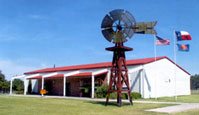|
November 10, 2013
WOLF CREEK HERITAGE MUSEUM NOTES by Virginia Scott MUSEUM HAPPENINGS As you are aware the construction on our new addition has begun and the cement slab was poured prior to the recent rain. The rain with its wind came from the south and under the exit door of our present building so we spent Wednesday soaking up the rainwater and arranging for sand bags for the door until the construction begins on the new building. We also cleared the south wall area because they will be breaking through the wall to install new doors. Stay tuned for further updates and expect new changes with each visit. Please come and visit the Quanah Parker and Sage Kinsey exhibits. This combination of past and present is a wonderful visual treat. Remember that the museum will close for the month of December so you have three weeks to visit left in 2013. That's 15 days left in the 2013 museum year. HISTORICAL MUSINGS As always I am writing this on Monday. This Monday is November 11, Veterans' Day and there will be recognition events throughout the county today and I hope you all attended at least one of them to recognize our veterans. The museum needs the names and service information on veterans from the Persian Gulf conflict to present. Please email these names to us at wolfcrk@amaonline. com or call us at 806-852-2123 or mail us your information to box 5, Lipscomb, TX 79056. Veteran's Day is always observed on November 11, regardless of the day of the week on which it falls. The Veterans Day National Ceremony is held on Veterans Day itself. When a holiday falls on a non-workday-Saturday or Sunday the holiday usually is observed by the federal government on Monday (if the holiday falls on Sunday) or Friday (if the holiday falls on Saturday). A law passed in 1968 changed the national commemoration of Veterans Day to the fourth Monday in October. It soon became apparent, however, that November 11 was a date of historic significance to many Americans. Therefore, in 1978 Congress returned the observance to its traditional date. Below explains why: In 1918, on the eleventh hour of the eleventh day in the eleventh month, the world rejoiced and celebrated. After four years of bitter war, the Allied powers signed a cease-fire agreement (an Armistice) with Germany at Rethondes, France on November 11, 1918, bringing World War I to a close. The "war to end all wars" was over. November 11, 1919 was set aside as Armistice Day in the United States, to remember the sacrifices that men and women made during World War I in order to ensure a lasting peace. On Armistice Day, soldiers who survived the war marched in a parade through their home towns. Politicians and veteran officers gave speeches and held ceremonies of thanks for the peace they had won. Armistice day officially received its name in the United States in 1926 through a Congressional resolution. It became a national holiday 12 years later. Congress voted Armistice Day a federal holiday in 1938, 20 years after the war ended. But Americans realized that the previous war would not be the last one. World War II began the following year and nations great and small again participated in a bloody struggle. After the second World War, Armistice Day continued to be observed on November 11. In 1953, townspeople in Emporia, Kansas called the holiday Veterans' Day in gratitude to the veterans in their town. Soon after, Congress passed a bill introduced by a Kansas congressman renaming the federal holiday to Veterans'' Day. Beginning in 1954, The United States designated November 11 as Veterans Day to honor veterans of all U. S. Wars. Veterans of military service have organized support groups such as the American Legion and Veterans of Foreign Wars. On Veterans' Day and Memorial Day, these groups raise funds for their charitable activities by selling paper poppies made by disabled veterans. This bright red wildflower became a symbol of World War I after a bloody battle in a field of poppies called Flanders Field in Belgium. |
 |
© 2006 - 2025 Wolf Creek Heritage Museum
All Rights Reserved |


